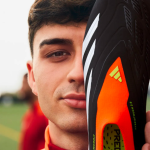
Tell me what football boots you make and I'll tell you who you are
Why in 2024 football shoes will signal the choices of major sports brands
January 22nd, 2024
"It's a real shame, but the world isn't ready yet," says the mad professor almost sarcastically, who seems to have stepped out of the Nickelodeon screens before Jude Bellingham, the version of Arsenio Lupin, escapes with the briefcase and scatters the guards as if they were Barcelona defenders. The treasure contained within the 24-hour briefcase is none other than a brand new pair of adidas Predators, ingeniously designed so that every ball hit is deflected under the cross of the hull, which Bellingham immediately tries out on a pitch to the amazement of those present. But perhaps the most ironic aspect of the entire, beautiful adidas video for the new release of the adidas Predator lies in this supposedly futuristic dystopia, in a world not yet ready for the arrival of a football boot that will change the way the most beautiful sport in the world is played, when we are talking about a boot invented by former Liverpool midfielder Craig Johnston in 1994 and whose 30th anniversary we are celebrating this year. An iconic shoe that has been worn by some of the most iconic and resounding feet of the past generation and is back in style for the next gen.
This is of course due to the immortal shape defined by the three stripes that become fangs or claws, carved around an extra-large tongue that should have no place in modern technical material, where the details are worked to the bone. Instead, Jude Bellingham and Trent Alexander-Arnold can't wait to wear it, drunk on a memory they've never experienced but somehow want to be a part of. And so adidas is building a history through some of its historic, and, to use a more uncomfortable word, classic models that are being cleansed of the dust of the past to be worn again by a generation that has never experienced them before. As with the Samba or the Spezial, for example, shoes that belonged to various subcultures in the past, from English hooligans to punks or Brit-pop, finally arrived in the TikTok feeds without any historical aura and ready to complete an outfit check. A strategy that proved extremely successful and which adidas also utilised in the run-up to the launch of the new Predator boots. An exciting remix of 30 years of history, presented as the future.
Nike Air Max Mercurial Tn: Against all tradition
While adidas has chosen the path of expanding its archive and introducing models and silhouettes that are recurring protagonists to a new audience, Nike has taken a radically different route. Earlier this year, Kylian Mbappé turned up at Paris Saint-Germain's training camp with a very special pair of shoes on his feet, a pair of Nike Air Max Mercurial Tn that have been merged from two Nike models that normally belong to different universes. On the unmistakable shape of the shoe originally worn by Ronaldo, the scaled exoskeleton and the famous gradient purple version appear here for a synthesis that no one could have imagined before, but which, as the immediate sell-out shows, everyone needs. The meeting of lifestyle and performance does indeed seem to be the key to the strategy that the Swoosh has chosen for 2024, in continuity with what it has done in recent seasons. Thus, first Kylian Mbappé and then Marcus Thuram became the faces of this revolutionary shoe that will usher in a new trend.
Of course, customised shoes with instantly recognisable lifestyle shapes are not an invention of 2024, as Nike itself has already produced them by interpolating the Air Max 1 and the Jordan 1. Not to mention the many, many customised American Football cleats for NFL superstars, who always take great care to personalize the few elements of their playing uniforms, including the helmet. But the football world, which has always been more conservative in certain aspects than US sports, has preferred to keep the two separate and leave the increasingly intrusive lifestyle side on the sidelines. Nike, on the other hand, wants to reverse this trend and is targeting a younger, more urban audience than adidas, who share the brand's values and can be found in an iconic model like the Air Max Plus. The Swoosh wants to capitalise on this, as was already evident in the coordinated releases of the two top teams Inter and Barcelona. So let's expect a 2024 for Nike that focuses even more on the connection between football and fashion, but unlike its main competitors, more on the pitch than off it and with a commitment to communities and storylines rather than individual players.
PUMA, Coperni and sports contamination
PUMA, on the other hand, proposes a third strategy to interpose itself between the two parties to the dispute. After a long buying campaign among the testimonials of the German brand, which has also benefited from the choice of other companies, PUMA is now digging back into its historical archives, but is not limiting itself to the reintroduction of certain models, but is trying to enhance them through collaborations and new projects. The collaboration with Coperni, for example, goes in this direction, boldly combining Blokecore and Balletcore - two trends that at first glance seem far removed from each other, but instead enter into a dialogue and expand the possibilities of the relationship between fashion and sport. "It's built exactly like a football boot, but looks like a stylish shoe," said Heiko Desens, Global Creative Director of PUMA, when the creation was first presented on the catwalk, and now that the 90SQR - as the collaboration shoe is called - is finally available, this relationship is back on the agenda. The combination of FUTURE, the shoe designed for Neymar, with a dance shoe is in line with PUMA's mission to imagine sport as a complex universe in which different disciplines can coexist and influence each other, without barriers or limitations.
Of course, the German brand's work in Formula 1 is also moving in this direction, enlisting A$AP Rocky as creative director for the partnership and trying to make racewear the new sportswear trend. And, of course, combining football and motorsport, as it did last season with the Mercedes AMG Petronas customised shoes, for example, and as we can imagine it will do again now that it has much more room to manoeuvre.
So if adidas can make football shoes a lifestyle again by following the evolutionary path that the Samba took a few decades ago, the bet for Nike goes in the opposite direction, with the extra pitch that can become the protagonist of style in performance. PUMA, on the other hand, wants to place the aesthetics of a particular sport in a different format, enhancing both its own archive and its positioning efforts in different markets in recent years. After years in which football kits seemed to be the only relevant element of football, it is now up to footwear to measure the brands' choices for 2024.












